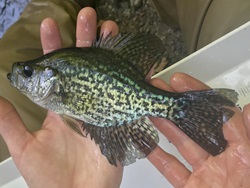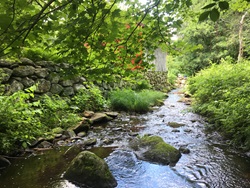Ambient Fish Community Monitoring



Fish are an important component of aquatic life in rivers and streams in Connecticut. The DEEP Water Monitoring Group therefore uses fish as one of three biological communities to evaluate the health of waterbodies in Connecticut. (The other two biological communities include benthic macroinvertebrates and diatoms.)
Fish have the ability to move within a reach to find better water quality, but they can only do so if there is adequate water present and no barriers to their movement such as dams. Fish are more sensitive to changes in the amount of water in a stream than other biological communities such as benthic macroinvertebrates, and a fish community with very limited fish can often be a signal of flow-related water quality impairments. Fish are therefore good indicators of problems related to water quantity and habitat connectivity.
Fish as Indicators of Water Quality
Fish community assessment work is challenging because Connecticut, compared to other regions in the country or world, has a very limited number of fish species. In addition, fish community structure at any given point in a stream or river is affected by human influences like dams, water withdrawal, or water quality issues.
The structure of a fish community at any given point of a stream or river in Connecticut depends upon both natural and human influenced variables. Naturally, the size of the stream and the water temperature regime (cold, cool, warm) dictate which species could be present. In general fish communities change from a trout dominated community in small cold water brooks and streams to a diverse community comprised of several minnow species, white sucker, darter, and eel in medium cool water streams, to finally sunfish and bass dominated systems in large warm rivers.
Program Development and Data Collection
Beginning around 1999, a long-term ambient fish community monitoring project was initiated as a partnership between the DEEP Fisheries Division and the DEEP Water Monitoring Group. Ambient fish community data are collected by electrofishing, a non-lethal method of collecting fish. Typically, as many fish as possible are netted, identified to species, and measured for total length to the nearest centimeter. Fish are then returned to the stream segment from which they were collected.
After many years of data collection and analysis two fish community multi metric indices (MMIs) were developed in cooperation with the University of Connecticut. A coldwater MMI is used to evaluate fish community data from small streams and the mixed-water MMI is generally used to evaluate data collected from larger streams and rivers. The MMI tools score a stream or river segment on a scale of 0-100; sites with a score of 47 or more are typically assessed as supporting aquatic life use goals for water quality.
A second tool called the CT fish biological condition gradient (BCG) model was also developed to evaluate data. The BCG model assigns a site to a tier between 1 and 5. Sites that represent a completely natural, unaltered fish community and related habitat are placed into Tier 1. On the other end of the spectrum, severely degraded sites with significant alteration are placed in Tier 5. Typically, if a site is scored as tier 1-4 it is assessed as supporting aquatic life use goals for water quality. The tiered approach to assessment better supports efforts to insure that our healthy sites remain healthy and that impacted sites are improving in quality due to management and restoration efforts.
Fish community sampling is an important addition to the Water Monitoring Program. The integration of fish community assessment techniques into the program has led to overall program growth and, importantly, a notable increase in the miles of assessed rivers and streams since 2006.
Reports and Publications
- Standard Operating Procedures (SOP) - Revised May 2019
- Dual Fish MMI Development Report
- Fish Community BCG Development Report
- CT Fish Community Summer Thermal Thresholds Report
Related Pages
- Freshwater Fish Community Data Viewer
- Water Monitoring Program Overview
- CT Fishing (General Information)
For More Information Contact:
Ansel Aarrestad
Ambient Fish Community Monitoring Program Lead
Water Monitoring and Assessment Program
79 Elm Street, Hartford, CT 06106
ansel.aarrestad@ct.gov
(860) 424-3349
Content last updated March 11, 2024.

